2016 MERCEDES-BENZ GL sensor
[x] Cancel search: sensorPage 74 of 462
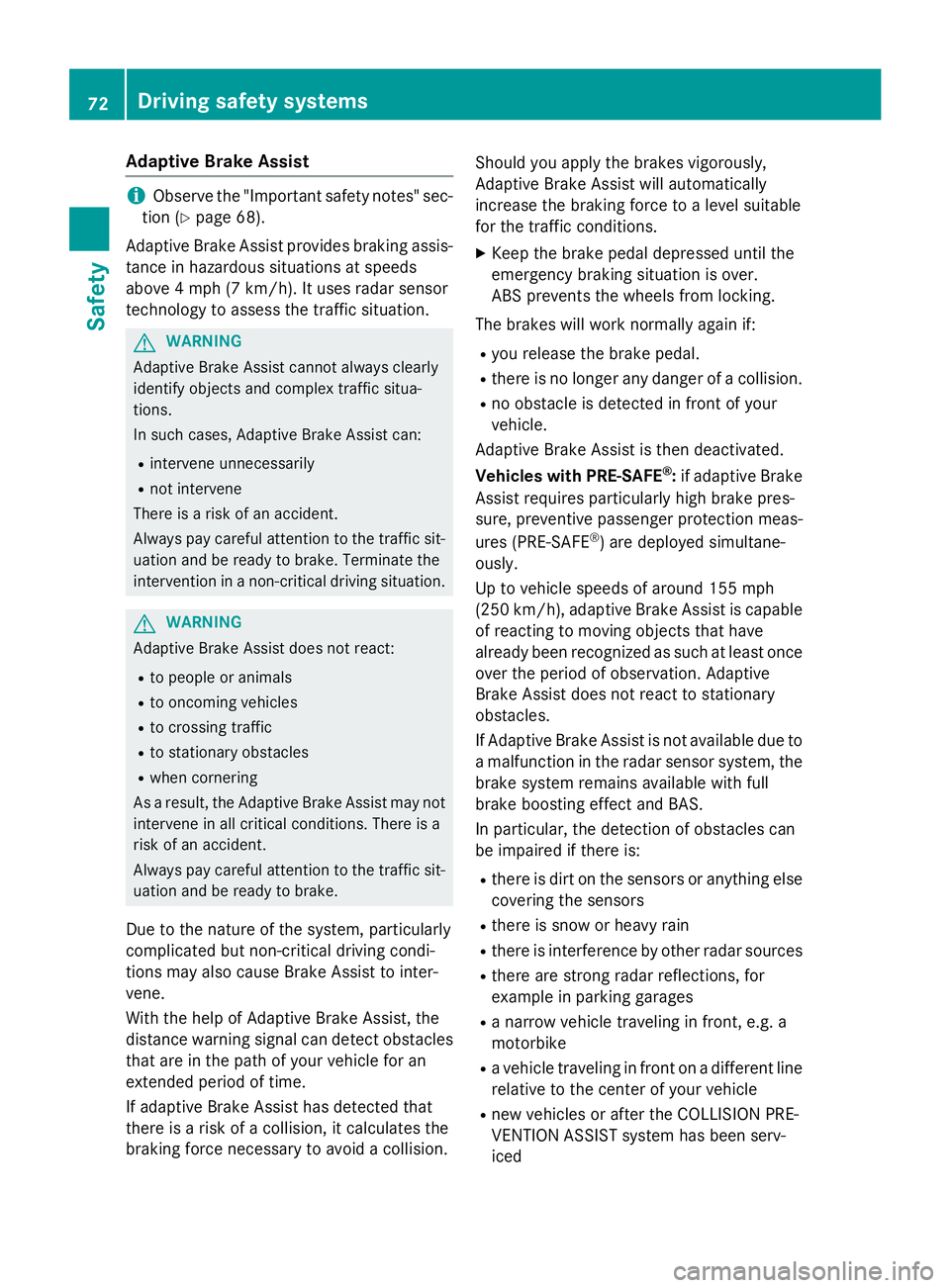
Adaptive Brake Assist
i Obs erv e th e "Importan t safet y notes" sec -
tion ( Y
page 68) .
Adaptive Brake Assis t provide s braking assis-
tance in hazardous situation s at speeds
abov e 4 mph (7 km/h). It uses radar sensor
technology to assess th e traffic situation .
G WARNIN G
Adaptive Brake Assis t canno t always clearly
identify objects and complex traffic situa-
tions.
In suc h cases, Adaptive Brake Assis t can :R
interven e unnecessarilyR
no t interven e
There is a ris k of an accident.
Always pay careful attention to th e traffic sit -
uation and be read y to brake. Terminate th e
intervention in a non-critical drivin g situation .
G WARNIN G
Adaptive Brake Assis t does no t react:R
to people or animals R
to oncomin g vehiclesR
to crossing traffic R
to stationary obstacles R
when cornering
As a result , th e Adaptive Brake Assis t may no t
interven e in all critical conditions. There is a
ris k of an accident.
Always pay careful attention to th e traffic sit -
uation and be read y to brake.
Due to th e nature of th e system, particularly
complicated but non-critical driving condi-
tion s may also caus e Brake Assis t to inter-
vene.
Wit h th e help of Adaptive Brake Assist, th e
distanc e warning signal can detec t obstacles
that are in th e pat h of your vehicl e for an
extended period of time.
If adaptive Brake Assis t has detecte d that
there is a ris k of a collision , it calculates th e
braking force necessar y to avoi d a collision . Should you apply th e brakes vigorously,
Adaptive Brake As sist will automatically
increas e th e braking force to a level suitable
for th e traffic conditions. X
Kee p th e brak e pedal depressed until th e
emergenc y braking situation is over.
AB S prevents th e wheels from locking .
The brakes will wor k normally again if: R
you release th e brak e pedal .R
there is no longer any danger of a collision .R
no obstacle is detecte d in fron t of your
vehicle.
Adaptive Brake As sist is then deactivated.
Vehicles wit h PRE-SAFE ®
: if adaptive Brake
Assis t require s particularly high brak e pre s-
sure, preventive passenger protection meas -
ures (PRE-SAF E ®
) are deployed sim ultane -
ously.
Up to vehicl e speeds of aroun d 15 5 mph
(25 0 km/h), adaptive Brake Assis t is capable
of reacting to moving objects that hav e
already been recognized as suc h at least once
ove r th e period of observation . Adaptive
Brake Assis t does no t reac t to st ationary
obstacles.
If Adaptive Brake As sist is no t available due to
a malfunction in th e radar sensor system, th e
brak e system remain s available wit h full
brak e boosting effec t and BAS.
In particular, th e detection of obstacles can
be impaire d if there is: R
there is dirt on th e sensors or anythin g else
covering th e sensors R
there is sn ow or heav y rainR
there is interferenc e by other radar source sR
there are st ron g radar reflections, for
exampl e in parking garages R
a narrow vehicl e traveling in front, e.g. a
motorbik e R
a vehicl e traveling in fron t on a differen t lin e
relative to th e center of your vehicl eR
ne w vehicles or after th e COLLISION PRE -
VE NTION ASSIST system has been ser v-
ice d72
Driving safety systems
Safety
Page 75 of 462
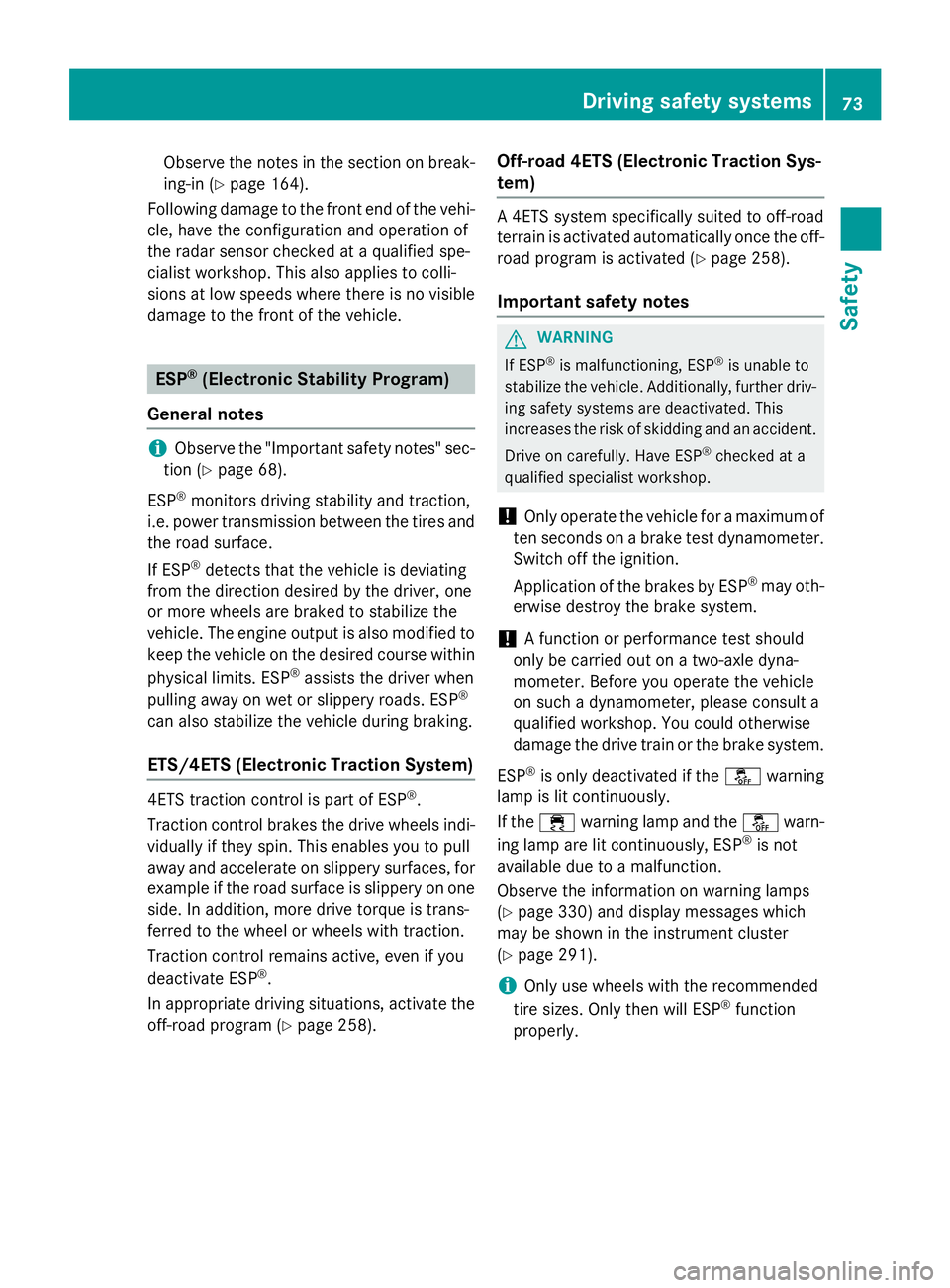
Observe the notes in the section on break-
ing-in ( Y
page 164).
Following damage to the front end of the vehi-
cle, have the configuration and operation of
the radar sensor checked at a qualified spe-
cialist workshop. This also applies to colli-
sions at low speeds where there is no visible
damage to the front of the vehicle.
ESP ®
(Electronic Stability Program)
General notes
i Observe the "Important safety notes" sec-
tion ( Y
page 68).
ESP ®
monitors driving stability and traction,
i.e. power transmission between the tires and
the road surface.
If ESP ®
detects that the vehicle is deviating
from the direction desired by the driver, one
or more wheels are braked to stabilize the
vehicle. The engine output is also modified to
keep the vehicle on the desired course within
physical limits. ESP ®
assists the driver when
pulling away on wet or slippery roads. ESP ®
can also stabilize the vehicle during braking.
ETS/4ETS (Electronic Traction System)
4ETS traction control is part of ESP ®
.
Traction control brakes the drive wheels indi-
vidually if they spin. This enables you to pull
away and accelerate on slippery surfaces, for
example if the road surface is slippery on one
side. In addition, more drive torque is trans-
ferred to the wheel or wheels with traction.
Traction control remains active, even if you
deactivate ESP ®
.
In appropriate driving situations, activate the
off-road program ( Y
page 258). Off-road 4ETS (Electronic Traction Sys-
tem) A 4ETS system specifically suited to off-road
terrain is activated automatically once the off-
road program is activated ( Y
page 258).
Important safety notes
G WARNING
If ESP ®
is malfunctioning, ESP ®
is unable to
stabilize the vehicle. Additionally, further driv-
ing safety systems are deactivated. This
increases the risk of skidding and an accident.
Drive on carefully. Have ESP ®
checked at a
qualified specialist workshop.
! Only operate the vehicle for a maximum of
ten seconds on a brake test dynamometer.
Switch off the ignition.
Application of the brakes by ESP ®
may oth-
erwise destroy the brake system.
! A function or performance test should
only be carried out on a two-axle dyna-
mometer. Before you operate the vehicle
on such a dynamometer, please consult a
qualified workshop. You could otherwise
damage the drive train or the brake system.
ESP ®
is only deactivated if the �
Page 78 of 462
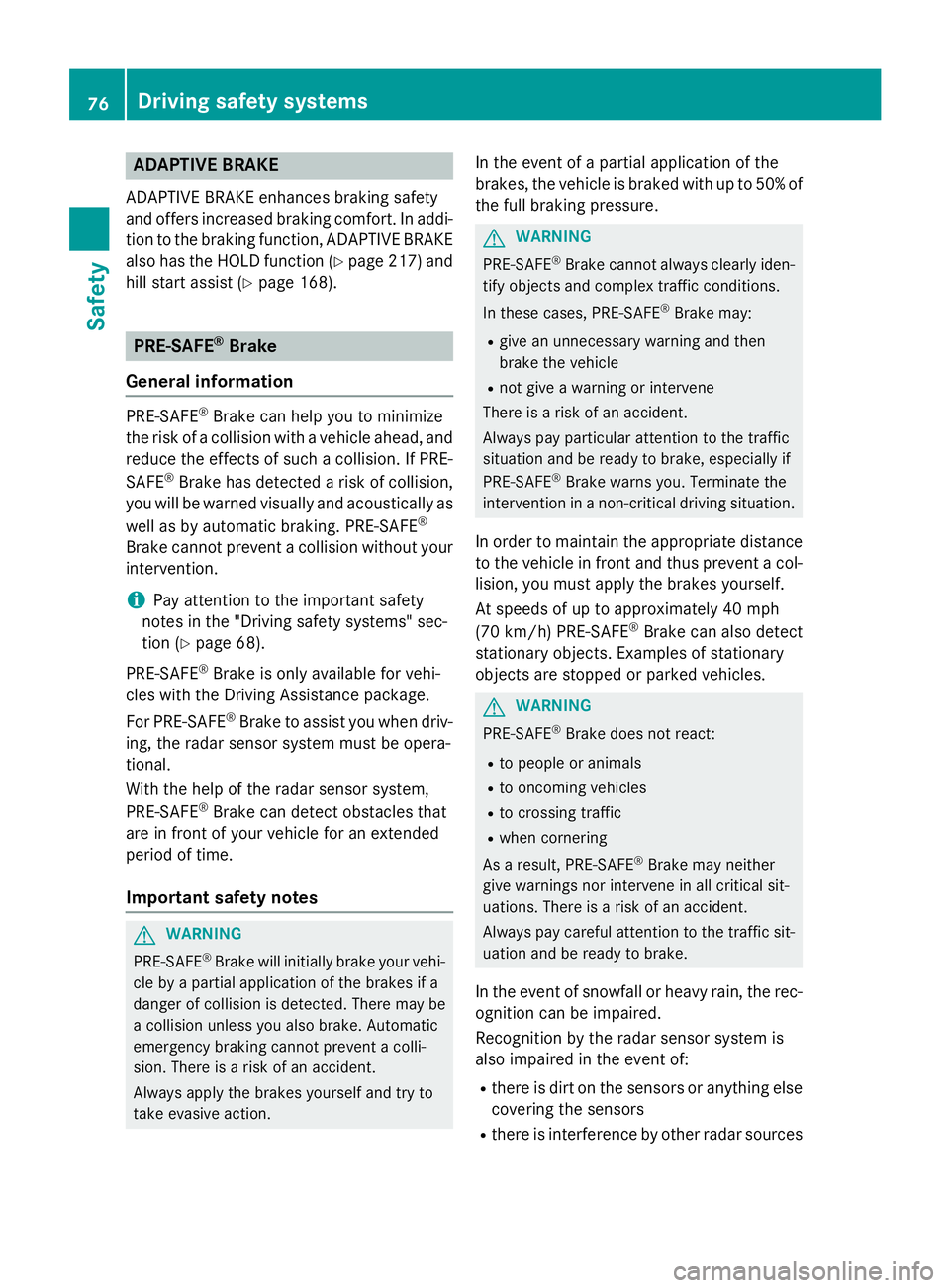
ADAPTIVE BRAKEADAPTIV E BRAKE enhance s braking safet y
and offers increased braking comfort . In addi-
tion to th e braking function , ADAPTIV E BRAKE
also has th e HOLD function ( Y
page 217) and
hill start assist ( Y
page 168).
PRE-SAFE ®
Brake
Gene ra l inf orm ationPRE-SAF E ®
Brake can help you to minimiz e
th e ris k of a collision wit h a vehicl e ahead , and
reduce th e effects of suc h a collision . If PRE -
SAFE ®
Brake has detecte d a ris k of collision ,
you will be warned visually and acoustically as
well as by automatic braking . PRE-SAF E ®
Brake canno t preven t a collision without your
intervention .
i Pay attention to th e important safet y
note s in th e "Drivin g safet y systems " sec -
tion ( Y
page 68) .
PRE ‑ S AF E ®
Brake is only available for vehi-
cle s wit h th e Drivin g Assistance package.
Fo r PRE-SAF E ®
Brake to assist you when driv -
ing , th e radar sensor system mus t be opera-
tional.
Wit h th e help of th e radar sensor system,
PRE-SAF E ®
Brake can detec t obstacles that
are in fron t of your vehicl e for an extended
period of time.
Import ant safety notes
G WARNIN G
PRE-SAF E ®
Brake will initially brak e your vehi-
cle by a partial application of th e brakes if a
danger of collision is detected. There may be
a collision unless you also brake. Automatic
emergenc y braking canno t preven t a colli-
sion . There is a ris k of an accident.
Always apply th e brakes yourself and tr y to
tak e evasive action . In th e event of a partial application of th e
brakes, th e vehicl e is braked wit h up to 50 % of
th e full braking pressure.
G WARNIN G
PRE-SAF E ®
Brake canno t always clearly iden -
tify objects and comple x traffic conditions.
In these cases, PRE-SAF E ®
Brake may:R
giv e an unnecessary warning and then
brak e th e vehicl e R
no t giv e a warning or interven e
There is a ris k of an accident.
Always pay particular attention to th e traffic
situation and be read y to brake, especially if
PRE-SAF E ®
Brake warn s you. Terminate th e
intervention in a non-critical drivin g situation .
In order to maintai n th e appropriat e distanc e
to th e vehicl e in fron t and thus preven t a col-
lision, you mus t apply th e brakes yourself .
At speeds of up to approximately 40 mph
(70 km/h ) PRE-SAF E ®
Brake can also detec t
stationary objects . Examples of stationary
objects are st oppe d or parked vehicles.
G WARNIN G
PRE-SAF E ®
Brake does no t react:R
to people or animals R
to oncomin g vehicles R
to crossing traffic R
when cornering
As a result , PRE-SAF E ®
Brake may neither
giv e warning s no r interven e in all critical sit -
uations. There is a ris k of an accident.
Always pay careful attention to th e traffic sit -
uation and be read y to brake.
In th e event of snowfall or heav y rain , th e rec -
ognition can be impaired.
Recognition by th e radar sensor system is
also impaire d in th e event of: R
there is dirt on th e sensors or anythin g else
covering th e sensors R
there is interferenc e by other radar source s76
Driving safety systems
Safety
Page 79 of 462
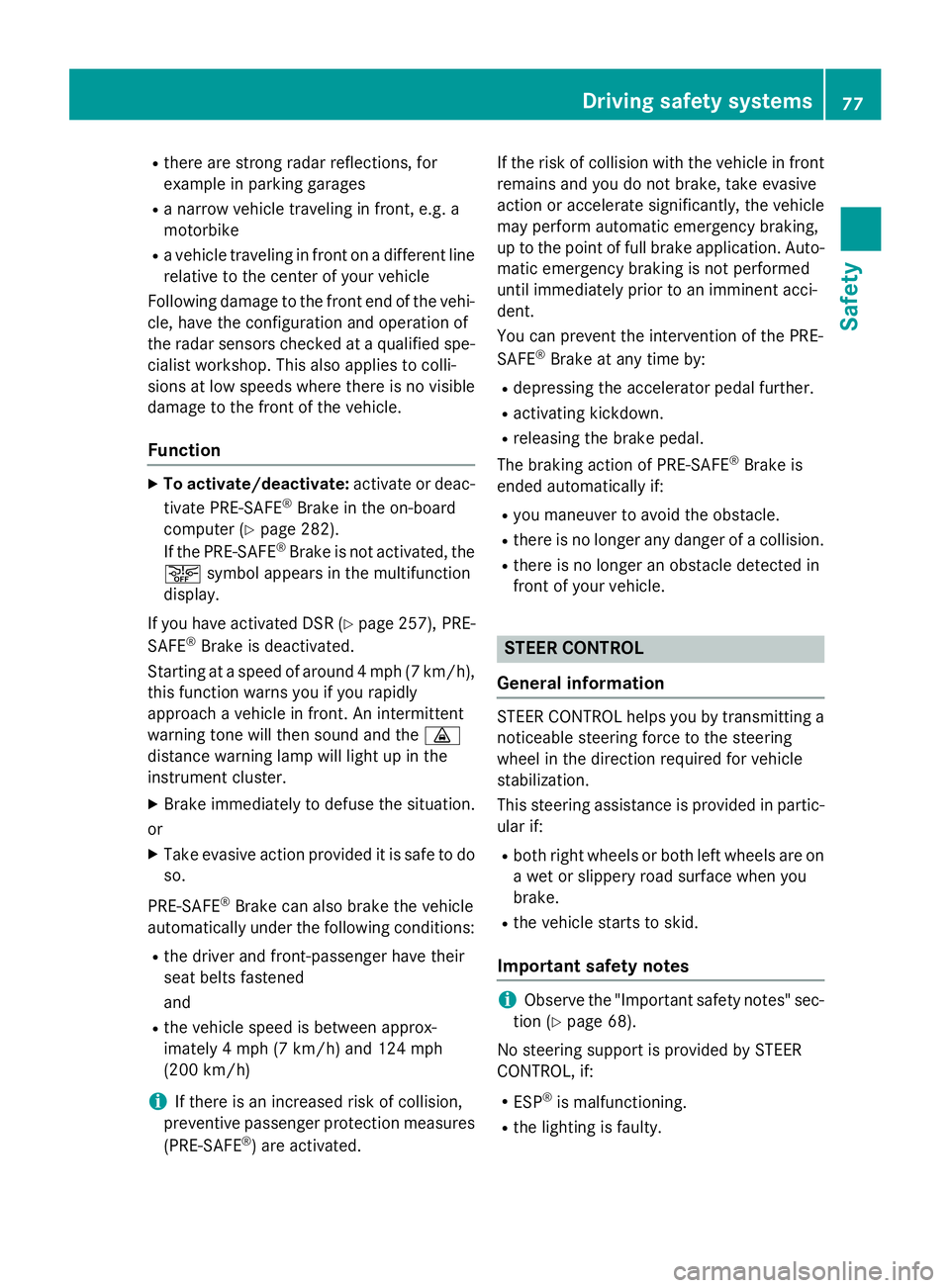
R
there are strong radar reflections, for
example in parking garages R
a narrow vehicle traveling in front, e.g. a
motorbike R
a vehicle traveling in front on a different line
relative to the center of your vehicle
Following damage to the front end of the vehi-
cle, have the configuration and operation of
the radar sensors checked at a qualified spe-
cialist workshop. This also applies to colli-
sions at low speeds where there is no visible
damage to the front of the vehicle.
Function X
To activate/deactivate: activate or deac-
tivate PRE-SAFE ®
Brake in the on-board
computer ( Y
page 282).
If the PRE-SAFE ®
Brake is not activated, the
�
Page 85 of 462

If you do not open the vehicle within
approximately 40 seconds of unlocking: R
the vehicle is locked again. R
protection against theft is reactivated. X
To lock centrally: press button �C .
The SmartKey centrally locks and unlocks the
following components: R
the doors R
the tailgate R
the fuel filler flap
The turn signals flash once when unlocking
and three times when locking.
You can also set an audible signal to confirm
that the vehicle has been locked. The audible
signal can be activated and deactivated using
the on-board computer ( Y
page 285).
You will receive visual and acoustic locking
confirmation if all components were able to
be locked.
When it is dark, the surround lighting also
comes on if it is activated in the on-board
computer ( Y
page 284).
KEYLESS-GO
General notes
Bear in mind that the engine can be started by
any of the vehicle occupants if there is a KEY-
LESS-GO key in the vehicle.
Locking/unlocking centrally
You can start, lock or unlock the vehicle using
KEYLESS-GO. To do this, you only need carry
the SmartKey with you. You can combine the
functions of KEYLESS-GO with those of a con-
ventional SmartKey. Unlock the vehicle by
using KEYLESS-GO, for instance, and lock it
using the �7 button on the SmartKey.
When locking or unlocking with KEYLESS-GO,
the distance between the SmartKey and the
corresponding door handle must not be
greater than 3 ft (1 m). KEYLESS-GO checks whether a valid Smart-
Key is in the vehicle by periodically establish-
ing a radio connection between the vehicle
and the SmartKey. This happens: R
when the external door handles are
touched R
when starting the engine R
while the vehicle is in motion
X
To unlock the vehicle: touch the inner
surface of the door handle. X
To lock the vehicle: touch sensor sur-
face �C . X
Convenience closing feature: touch
recessed sensor surface �D for an exten-
ded period.
Further information on the convenience clos-
ing feature ( Y
page 99).
If you pull on the handle of the tailgate, only
the cargo compartment of the vehicle is
unlocked.
Deactivating and activating
If you do not intend to use a key for an exten-
ded period of time, you can deactivate the
KEYLESS-GO function of the SmartKey. The
SmartKey will then use very little power,
thereby conserving battery power. For the
purposes of activation/deactivation, the
vehicle must not be nearby. SmartKey 83
Opening and closing Z
Page 86 of 462

X
To deactivate: press the �7 button on
the SmartKey twice in rapid succession.
The battery check lamp ( Y
page 85) of the
SmartKey flashes twice briefly and lights up
once, then KEYLESS-GO is deactivated. X
To activate: press any button on the
SmartKey or insert the SmartKey into the
ignition lock.
KEYLESS-GO and all of its associated fea-
tures are available again.
KEYLESS-GO start functionBear in mind that the engine can be started by
any of the vehicle occupants if there is a
SmartKey in the vehicle.
Changing the settings of the locking
systemYou can change the settings of the locking
system. This means that only the driver's door
and the fuel filler flap are unlocked when the
vehicle is unlocked. This is useful if you fre-
quently travel on your own. X
To change the setting: press and hold
down the �6 and �7 buttons simulta-
neously for approximately six seconds until
the battery check lamp flashes twice
( Y
page 85).
i If the setting of the locking system is
changed within the signal range of the vehi-
cle, pressing the �7 or �6 button:R
locks or R
unlocks the vehicle
The SmartKey now functions as follows: X
To unlock the driver's door: press the
�6 button once.X
To unlock centrally: press the �6 but-
ton twice. X
To lock centrally: press the �7 button. The KEYLESS-GO function is changed as fol-
lows: X
To unlock the driver's door: touch the
inner surface of the door handle on the
driver's door. X
To unlock centrally: touch the inner sur-
face of the door handle on the front-
passenger door or the rear door. X
To lock centrally: touch the outer sensor
surface on one of the door handles
( Y
page 83). X
To restore the factory settings: press
and hold down the �6 a nd �7 b uttons
simultaneously for approximately six sec-
onds until the battery check lamp flashes
twice ( Y
page 85).
Mechanical key
General notes If the vehicle can no longer be locked or
unlocked with the SmartKey, use the
mechanical key.
If you use the mechanical key to unlock and
open the driver's door, the anti-theft alarm
system will be triggered ( Y
page 78).
There are several ways to turn off the alarm: X
To turn the alarm off with the SmartKey:
press the �6 or �7 button on the
SmartKey.
or X
Insert the SmartKey into the ignition lock.
or X
To deactivate the alarm with KEYLESS-
GO: press the Start/Stop button in the igni-
tion lock. The SmartKey must be in the
vehicle.
or X
Lock or unlock the vehicle using KEYLESS-
GO. The SmartKey must be outside the
vehicle.84
SmartKey
Opening and closing
Page 102 of 462
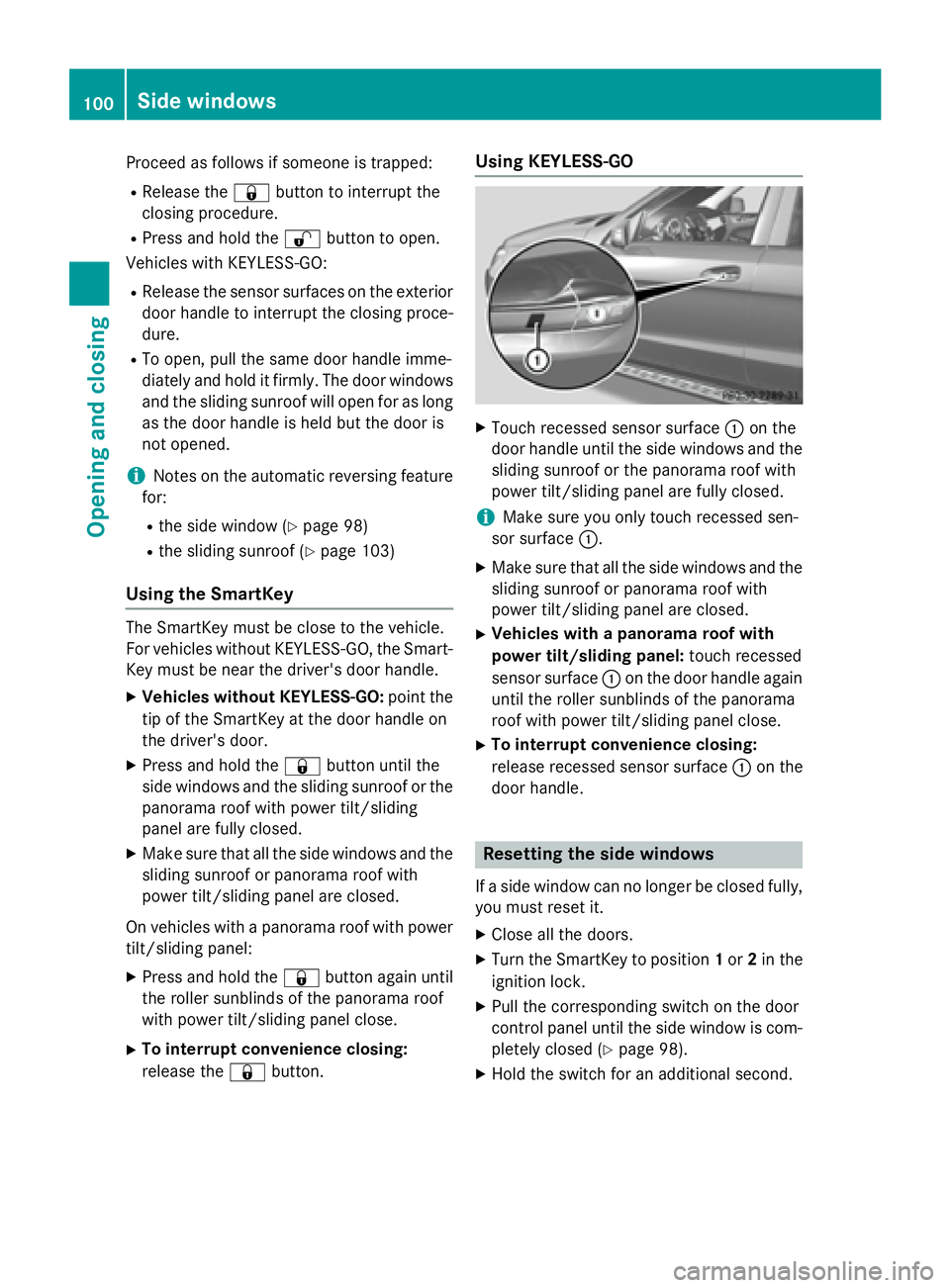
Proceed as follows if someone is trapped: R
Release the �7 button to interrupt the
closing procedure. R
Press and hold the �6 button to open.
Vehicles with KEYLESS-GO: R
Release the sensor surfaces on the exterior
door handle to interrupt the closing proce-
dure. R
To open, pull the same door handle imme-
diately and hold it firmly. The door windows
and the sliding sunroof will open for as long
as the door handle is held but the door is
not opened.
i Notes on the automatic reversing feature
for: R
the side window ( Y
page 98)R
the sliding sunroof ( Y
page 103)
Using the SmartKey The SmartKey must be close to the vehicle.
For vehicles without KEYLESS-GO, the Smart-
Key must be near the driver's door handle. X
Vehicles without KEYLESS-GO: point the
tip of the SmartKey at the door handle on
the driver's door. X
Press and hold the �7 button until the
side windows and the sliding sunroof or the
panorama roof with power tilt/sliding
panel are fully closed. X
Make sure that all the side windows and the
sliding sunroof or panorama roof with
power tilt/sliding panel are closed.
On vehicles with a panorama roof with power
tilt/sliding panel: X
Press and hold the �7 button again until
the roller sunblinds of the panorama roof
with power tilt/sliding panel close. X
To interrupt convenience closing:
release the �7 button. Using KEYLESS-GO X
Touch recessed sensor surface �C on the
door handle until the side windows and the
sliding sunroof or the panorama roof with
power tilt/sliding panel are fully closed.
i Make sure you only touch recessed sen-
sor surface �C . X
Make sure that all the side windows and the
sliding sunroof or panorama roof with
power tilt/sliding panel are closed. X
Vehicles with a panorama roof with
power tilt/sliding panel: touch recessed
sensor surface �C on the door handle again
until the roller sunblinds of the panorama
roof with power tilt/sliding panel close. X
To interrupt convenience closing:
release recessed sensor surface �C on the
door handle.
Resetting the side windows
If a side window can no longer be closed fully,
you must reset it. X
Close all the doors. X
Turn the SmartKey to position 1 or 2 in the
ignition lock. X
Pull the corresponding switch on the door
control panel until the side window is com-
pletely closed ( Y
page 98). X
Hold the switch for an additional second.100
Side windows
Opening and closing
Page 128 of 462

If you come into contact with the electrolyte,
observe the following: R
Rinse off the electrolyte from your skin
immediately with water. R
Immediately rinse the electrolyte out of
your eyes thoroughly with clean water. R
If the electrolyte is swallowed, immediately
rinse your mouth out thoroughly. Do not
induce vomiting. R
If electrolyte comes into contact with your
skin or hair or is swallowed, seek medical
attention immediately. R
Immediately change out of clothing which
has come into contact with electrolyte. R
If an allergic reaction occurs, seek medical
attention immediately.
The rear-view mirror and the exterior mirror
on the driver's side automatically go into anti-
glare mode if the following conditions are met
simultaneously: R
the ignition is switched on and R
incident light from headlamps strikes the
sensor in the rear-view mirror
The mirrors do not go into anti-glare mode if
reverse gear is engaged or if the interior light-
ing is switched on. Parking position for the exterior mir-
ror on the front-passenger side
Setting and storing the parking position Using reverse gear
�C
Button for the driver's side exterior mirror �D
Button for the front-passenger side exte-
rior mirror �